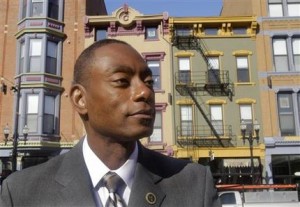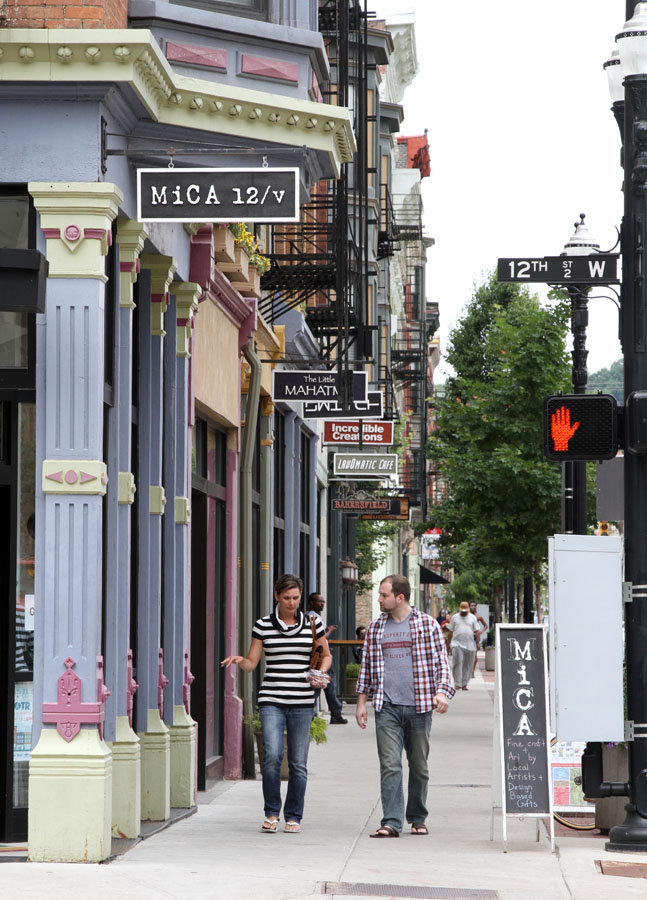Mayor Mark Mallory on How Smart Growth Helped Turn Cincinnati Around
3:39 PM EST on February 11, 2013
About seven years ago, when Mayor Mark Mallory came on the scene, Cincinnati was at a low point. To convince the crowd at the New Partners for Smart Growth conference in Kansas City last week of the gravity of the situation, Mallory started off with a story about livestock.

A little before Mallory was elected, a cow escaped from a city slaughterhouse. (Cincinnati, a historic meat-packing city, was once known informally as Porkopolis.) A search was launched, with police helicopters scouring the city. "They looked for the cow for 11 days," Mallory said. "This was a sad period of Cincinnati. We just couldn’t do things right."
The cow anecdote (which Cincinnati officials assure us is true) was actually a gentle way of putting it.
In 2001, four years before Mallory took office, incidents of police brutality led to upheaval in the streets on the city's north side. The Cincinnati riots, which continued for four days, were reportedly the largest in the United States since the 1992 Los Angeles riots following the Rodney King verdict.
For a long time that period clouded the city's national reputation. But more and more, Cincinnati is seen as a promising urban comeback story. And Mallory -- a strong proponent of walkable development -- credits smart growth principles for the turnaround.
"Cincinnati’s like a lot of cities around the country," he told the conference. "We saw our best times from around the turn of the century to the 1960s. Then, like a lot of cities, we saw a period of decline. We languished for decades. Our biggest problem in Cincinnati is that we had lost our way. We had forgotten what it was like to be a progressive city. We’d forgotten what it was like to be on the cutting edge."
"I set out to change the way we did business in Cincinnati," he said. "You have to have dynamic leadership."
As mayor, Mallory began by addressing the real and perceived crime problem. He added police officers to the street, and he also tried to get more regular people, not just cops, back on the sidewalks. One thing Mallory has done during his two terms is to tear down the city's enclosed skywalks, one by one.

"Smart growth itself is a crime fighting initiative," he said. "The more people on the streets the safer you are."
Mallory also set out to transform the reputation of the city's downtown. "People assess the safety and vitality of your city by your downtown," he said. "There was this perception problem that we had to deal with."
Fountain Square – a public space that serves as a focal point of the city’s downtown – had lost its luster.
“People would just go there basically to eat lunch and protest. Those were the two things you could do by city ordinance,” he joked.
The public square underwent a $44 million renovation in 2005, shortly after Mallory came into office. The city rebuilt the parking garage, enlarged the ice rink, built a public stage and a restaurant. They also built a water works play area for kids. That project has resulted in private renovations to many of the major retailers and hotels surrounding the square.
Meanwhile, the construction of new sports stadiums on Cincinnati's waterfront opened a large area near downtown for redevelopment. In 2008, the city began "The Banks," a $1 billion, mixed-use riverfront development. The project -- begun, notably, during the height of the real estate meltdown -- will include 300 apartments, 100 condominiums, 70,000 square feet of retail, and a 40-acre park.
“People said, ‘You need to wait for the economy to rebound,’” Mallory said, but he refused. “You have to continue to invest in your own future.”
The project was given the American Planning Association's National Planning Excellence Award this year.
Those two projects -- The Banks and Fountain Square -- also helped spur private development, most notably a new, $322 million office tower – the tallest building in Cincinnati -- for the Great American Insurance Company. Again, even more impressive, this enormous project began during the real estate meltdown.

Meanwhile, the city was working to reinvest in the Over the Rhine neighborhood, which had been the epicenter of rioting a decade before. Parts of the 2000 movie Traffic -- about the international drug trade -- were filmed in this neighborhood. At that time, it was one of the most economically distressed areas in the country, with a 58 percent poverty rate.
Since then, a local development firm called 3CDC has rehabbed or built almost 500 residential units and 127,000 square feet of commercial space, with help from the city. That commercial space, 3CDC reports, is currently 90 percent leased. 3CDC also led a $48 million renovation of the neighborhood's Washington Park.
The Cleveland Plain Dealer called the neighborhood's comeback "amazing."
"It's being seen as a national model," said Mallory, "$30 million in public money, so far, that’s leveraged $200 million in private spending."
The final major urban development success of the Mallory administration is the Cincinnati Streetcar. This 3.6 mile starter loop will return rail transit to the city for the first time since 1951 when it opens in 2015, in time for the All-Star Game at the Great American Ballpark.
But getting new investment in transit infrastructure in the state of Ohio was no easy task. The city of Cincinnati, with Mallory at the helm, fought off two referendums that sought to halt the project. The state of Ohio also attacked the project after Republican Governor John Kasich was elected in 2010; the state pulled $53 million in promised funding for the project.
Still, the city retooled and prevailed, piecing together the $110 million in funding from local, regional and national sources, public and private.
Mallory said the project required overcoming a great deal of local resistance, in part because of the city's troubled track record on rail development. In the early part of the 20th Century, Cincinnati had started to develop a subway system, but the project was abandoned before completion. It became a visible failure and embarrassment for the city.
But Mallory said it was important to remind the public that that was no reason not to pursue a modern streetcar.
"The failure wasn’t that we decided to build a subway, the failure is that we stopped," he said. "Imagine if we had built that subway, how big would we have grown."
Finally, Mallory said, he owes some of his foresight around progressive transportation to a local resident who pushed him: Cincinnati transit advocate John Schneider. When Mallory was a state senator, Schneider urged him to consider sustainable transportation options, helping to arrange a trip to Portland so that Mallory could see how that city had developed around transit stations.
"Over the last several years there were a lot of people who got to me," he said. "A transportation expert said to me, 'You've got to go to Portland.' And that convinced me that’s what we’ve got to be doing in Cincinnati."
That example should inspire other smart growth advocates to continue pressing their elected leaders, he said.
"Reengage the decision makers," said Mallory. "Push them to utilize smart growth strategies to create the 21st Century city."
Angie Schmitt is the author of Right of Way: Race, Class and the Silent Epidemic of Pedestrian Deaths in America, and the former editor of Streetsblog USA.
Stay in touch
Sign up for our free newsletter
More from Streetsblog USA
Should Wednesday’s Headlines 86 SUVs?
American tax law encourages people to buy the gas-guzzling and deadly vehicles, but some in Canada are pushing to ban them.
Tuesday’s Headlines Fix It First
How voters incentivize politicians to ignore infrastructure upkeep. Plus, are hydrogen trains the future of rail or a shiny distraction?
Why We Can’t End Violence on Transit With More Police
Are more cops the answer to violence against transit workers, or is it only driving societal tensions that make attacks more frequent?
Justice Dept., Citing Streetsblog Reporting, Threatens to Sue NYPD Over Cops’ Sidewalk Parking
The city is now facing a major civil rights suit from the Biden Administration if it doesn't eliminate illegal parking by cops and other city workers.
Five Car Culture Euphemisms We Need To Stop Using
How does everyday language hide the real impact of building a world that functionally requires everyone to drive?




